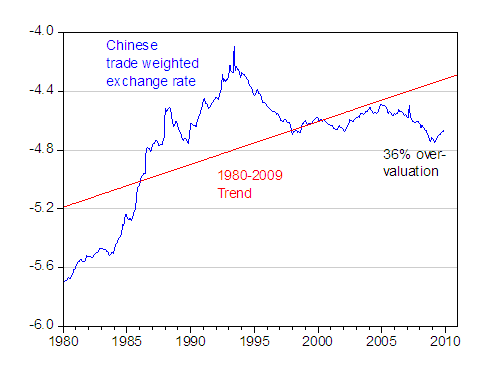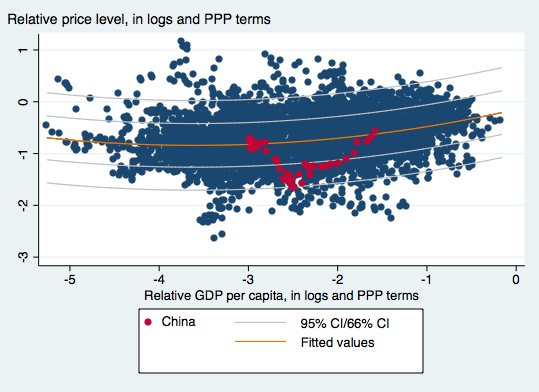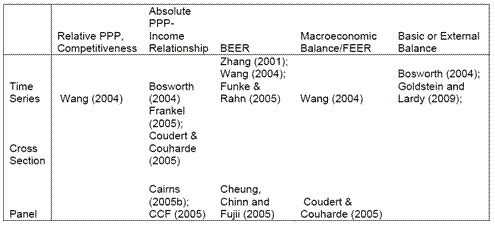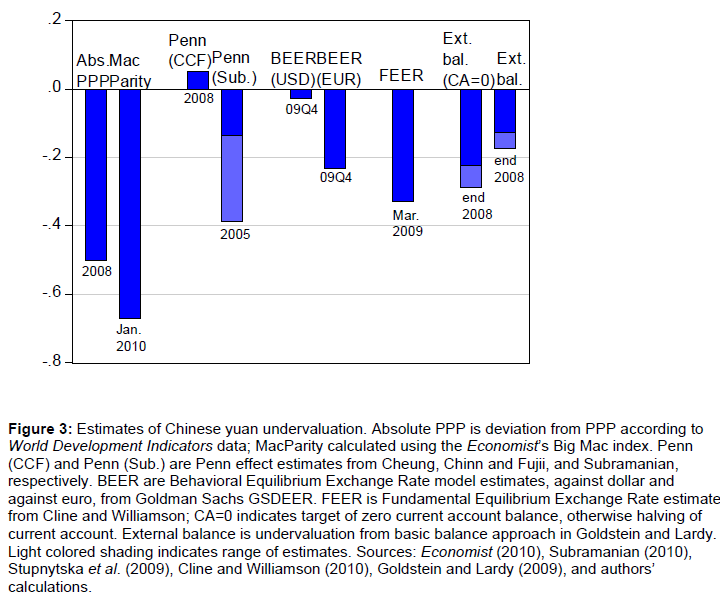As the administration pushes for “stability” in the Chinese exchange rate while imposing tariffs on China, it might be useful to recount the various ways in which different observers define currency “misalignment”. Here I update a primer first posted in 2010.
Currency misalignment can be determined on the basis of the following criteria or models:
- Relative purchasing power parity (PPP)
- Absolute purchasing power parity
- The “Penn Effect”
- The behavioral equilibrium exchange rate (BEER) approach
- The macroeconomic balance effect
- The basic flows approach
- An equilibrium approach
I have discussed several of these approaches in the past [0] [1], but a review of the approaches bear repeating, if only because there so much confusion regarding what constitutes currency misalignment.
Relative PPP
Relative PPP can be expressed as:
s = μ + p – p*
where lowercase letters denote log values, s is the price of foreign currency, p is the price index, and * denotes a foreign variable, and μ is a constant arising from the fact that p and p* are indices.
Using this criteria, a currency is misaligned if s deviates from the μ + p – p*. One difficulty is that μ has to be estimated. Typically, estimates of μ can vary drastically with sample period. Oftentimes, there is a time trend in q ( which equals s – μ – p + p*), which means that relative PPP cannot literally hold. Then, one might have to allow for a (ad hoc) time trend, which itself has to be estimated. In Chinn (Emerging Markets Review, 2000), I apply this approach to the East Asian currencies, pre-crisis.
In the case of China, presented below is the (log) trade weighted real effective exchange rate of China, (q), using the latest data spliced to an older series incorporating the swap rates pre-1994 per discussion in Chinn, Dooley, Shrestha (JIMF, 1999). Upwards denotes depreciation.

Using a simple linear trend, one obtains the counter-intuitive result that the RMB is overvalued. This suggests caution.
For more on effective exchange rates, see this survey paper (Open Econs. Review, 2015).
Absolute PPP
Given the drawback of relative PPP, it seems like one could get around the problem of estimating μ by using actual prices of identical bundles of goods across countries, rather than price indices.
s = p – p* or equivalently p = s + p*
where lowercase letters denote log values, s is the price of foreign currency, p is the price level, and * denotes a foreign variable.
The problem is that prices of identical bundles of goods are not collected. One thing that comes close is the Big Mac — hence the MacParity measure. But the problem is that prices of Big Macs (when expressed in a common currency) are systematically lower in lower income countries, and systematically higher in higher income countries. This is true when using Big Mac prices [2] [latest estimate] Parsley and Wei (2005) and when using the “price levels” in the Penn World Tables. This is so much a stylized fact that it is sometimes called “The Penn Effect”.
The Penn Effect
Instead of viewing the “Penn Effect” as a problem, one can exploit this stylized fact. Define r ≡ p – s – p*. Then one can exploit the relationship:
r = α 0 + α 1 (y-n)
Where y-n is log per capita income. In Cheung et al. (2008), we exploited this relationship (following Frankel (2005), in a panel regression setting. In that study, we found an approximate 40% RMB misalignment (in log terms).
In more recent work, we have adapted the analysis to incorporate nonlinearities (following Hassan, JIE 2016). In Cheung, Chinn and Nong (IF, 2017), we exploit the significant nonlinearity (a quadratic in per capita income) to find that as of the most recent data, China’s currency is not significantly undervalued, and plausibly is overvalued.

The Behavioral Equilibrium Exchange Rate (and related) Approach
Yet another approach is to use some theoretically and empirically motivated equations to estimate an exchange rate relationship. The variables can include productivity variables, or relative price of nontradables, or fiscal variables like the deficit, or interest differentials. Typically the variables can be motivated by some model of the exchange rate; which ones are included are motivated by goodness of fit. Goldman Sachs and JP Morgan had models of this sort. Zhang (China Economic Review, 2001) and Wang (2004) in Prasad (IMF, 2004) are some models in the public domain (see this 2007 Treasury occasional paper). Chinn (RIE, 2000) implements a specific type of BEER (or productivity based) model for East Asian exchange rates, while Ricci, Milesi-Ferretti and Lee (JMCB, 2013) examine a broader set of currencies. Chong, Jorda and Taylor (IER, 2012) look at long run income/exchange rate relationships (see this post).
A comprehensive set of estimates, updated regularly, is undertaken by Couharde et al. (EQCHANGE, described in this post).
The Macroeconomic Balance approach
The Macroeconomic Balance approach takes the perspective from saving and investment rates (see Peter Isard’s survey). Recall:
CA ≡ (T-G) + (S-I)
In other words, the current account is, by an accounting identity, equal to the budget balance and the private saving-investment gap. This is a tautology, unless one imposes some structure and causality. One can do this by taking the budget balance as exogenous (or use the cyclically adjusted budget balance), and then include the determinants of investment and saving. Then one obtains “norms” for the current account. Chinn and Prasad (JIE, 2003) is one example of this approach.
Then, using trade elasticities, one can back out the real exchange rate that would yield that current account. If that exchange rate is stronger than the actually observed exchange, then that currency would be considered “undervalued”.
Variations in this approach are numerous. One important question is whether to take official sector intervention as an exogenous (or somewhat exogenous) variable; doing so can yield a substantially different estimate of the normal current account balance, and hence equilibrium rate, as noted by Bayoumi, Gagnon and Saborowski (JIMF, 2015).
Starting in 2011, in a project I was somewhat involved in, the IMF began a process of revamping the approach. The External Balances Approach (EBA) emphasized desired policy factors such as social spending, and used annual data (see post here). The current formulation is embodied in the IMF’s External Sector Report.
The closely-related Fundamental Equilibrium Exchange Rate (FEER) determines the current account norm on a more judgmental basis (in other words, the current account norm is not estimated econometrically, just imposed per the analysts priors).
The Basic Balance approach
One could take a more ad hoc approach, asking what is the “normal” level of stable inflows — for instance looking at the sum of the current account and foreign direct investment, and see whether that value “made sense”. Or one could look at the sum of the current account and private capital inflows. If either of the flows are “too large”, then the currency would be considered undervalued (since a stronger currency would imply a smaller current account balance).
Note that a target value of zero for the current account or the basic balance is arbitrary, and does not in itself make sense. It behooves the serious analyst to remember this when considering, for instance, the Coalition for Prosperous America’s study.
It is interesting to make two observations. First, note the need for many non-model based judgments. To see this point, recall the balance of payments accounting definition:
CA + KA + ORT ≡ 0
Where CA is current account, KA is private capital inflows, and ORT is official reserves transactions (+ is a reduction in forex reserves).
Saying CA + KA is too big is the same, then, as saying ORT is too small, i.e., reserves are rising “too fast”. Morris Goldstein and Nick Lardy are among the most prominent exponents of this approach (see e.g., this this small volume).
Alternatively, running surpluses that are “too large” for “too long” will lead to foreign exchange reserves that are “too large”. Obviously, a lot of judgment is necessary here.
Second, one aspect of this judgment is that it is conditional on the constellation of all other macro policies, including monetary, fiscal and regulatory, in place. If the CA+KA is adjudged to be “too large”, one could say the exchange rate is “too weak”, but one could say with equal validity that the fiscal policy is “insufficiently expansionary”.
A (newer) Equilibrium View
The final approach would be to step back and think in terms of “equilibrium” exchange rates. One might argue that the exchange rate is undervalued if, in the absence of central bank intervention, the exchange rate would be stronger. Of course, this means that whenever any central bank pegs an exchange rate, then the exchange rate is definitionally misaligned. I suspect when people use this particular definition, it is usually conjoined with some sort of threshold. One problem in my mind with operationalizing this definition is figuring out what that the right “threshold” is.
A more fundamental conception of what an “equilibrium” exchange rate is is laid out by my colleague Charles Engel. As noted in this post, the equilibrium exchange rate is the one that minimizes the distortion from sticky prices and other rigidities. That is not necessarily the exchange rate delivered by a free float, even in the absence of capital controls. Indeed, it might be best delivered by some type of monetary policy (see the paper).
This approach departs from the “equilibrium” approach embodied in the real models of the late Alan Stockman, as summarized here, in that those models assumed away nominal rigidities. With complete markets, the free floating exchange rate is almost irrelevant since the real rate will always adjust to the “right” levels.
Review and Summing Up
Two last observations. First, each of these approaches has advantages and disadvantages. PPP and variants are easy to implement, but are more akin to parity conditions, so it’s not clear over what horizon they apply to. The macroeconomic balance and FEER approaches are most appropriate to the medium term, and hence perhaps more relevant to policy questions. But they require more judgment on the parameters of the models. Moving to the basic balance approach, the time horizon is the shortest, and of perhaps most interest to policy analysts, and yet requires the greatest subjective judgment, since one needs to take a strong stand on what constitutes the appropriate values for critical variables. (There are also data considerations as well — the PPP criteria is most popular in part because of the limited data requirements.)
Second, in some ways, it’s not necessarily correct to think of these approaches as all inconsistent (in some instances they might be). Better to think that some approaches are more appropriate at one horizon versus another horizon. (This echoes Richard Cooper’s description of how elasticities, absorption and monetarist interpretations were all consistent over time, in thinking about the effects of devaluations.)
I summarize the typology of studies in this table (which is adapted from Cheung et al. (2006).

Given the variety of concepts, multiplied by the number of statistical methodologies, and data sources, it’s no wonder estimates of misalignment differ. Figure 3 from Cheung, Chinn and Fujii (in Evenett (ed.), US-Sino Currency Debate, 2010) highlights the wide variation in estimates in the latter part of the 2000’s.

For everything one wants to know about purchasing power parity and real exchange rates determination, see this recent survey.
“The U.S. is asking China to keep the value of the yuan stable as part of trade negotiations between the world’s two largest economies, a move aimed at neutralizing any effort by Beijing to devalue its currency to counter American tariffs, people familiar with the ongoing talks said.”
WTF? Oh wait – his “economists” are all gold bugs. Got it!
Interesting story on Trump’s babbling about this issue from late August:
https://www.bloomberg.com/news/articles/2018-08-30/trump-says-u-s-looking-at-formula-for-china-yuan-manipulation
Trump has repeatedly complained that China manipulates the renminbi, also known as the yuan, a charge that isn’t officially supported by his government…Trump again alleged in an interview with Reuters last week that China was manipulating its currency. The president’s accusation, presented without explanation or substantiation, conflicts with the findings of his own administration. The Treasury Department stopped short of naming China, the EU or any other country as a currency manipulator in April, in a semi-annual report on foreign-exchange policy. “It is a formula,” Trump said Thursday. “And we are looking very strongly at the formula.”
Formula? WTF? What did the Chinese say?
The yuan has tumbled 6 percent over the past three months — making it the worst performer in Asia. In response, officials have taken actions to give them better control over the exchange rate. A reserve requirement that makes shorting the yuan costlier has also been reintroduced. The currency rebounded 1.4 percent since hitting the lowest since January 2017 earlier this month. China has said it won’t use competitive currency devaluation or the foreign exchange rate as a tool to cope with trade frictions. “The yuan’s exchange rate is decided by the market,” Li Bo, director of the People’s Bank of China’s monetary policy department, told reporters in Beijing earlier this month. He said the currency has more flexibility this year and the central bank is confident of keeping the rate “basically stable at a reasonable equilibrium level.”
Li Bo is making a lot more sense than Trump. But let’s check the data:
https://fred.stlouisfed.org/series/DEXCHUS/
The yuan has fluctuated in both directions since Trump was elected. Yes there were periods when it devalued but then there were periods when it appreciated. When Trump was elected, a dollar could buy 6.75 yuan. Now a dollar can buy 6.75 yuan.
This is a succinct and helpful overview.
Thanks again, Menzie. And Is it still the widely accepted wisdom that we see weak reversion towards some PPP measure of equilibrium in the data? This is my current understanding. Again, that is (or was) a weak reversion, like 15% per year, and often and easily disrupted by various shocks and anomalies.
Barkley Rosser: Yes, for advanced economies of similar income levels. Developing countries such as China do (and should) see trends in real rates.
FRED charts the Real Broad Effective Exchange Rate for China from 1994 to today:
https://fred.stlouisfed.org/series/RBCNBIS
There has been a considerable real appreciation of China’s exchange rate over time – which is what one would expect for a country that has seen dramatic increases in its productivity. Of Team Trump appears to be quite unaware of this fact as he keeps talking about yuan devaluation. Of course we have long known Trump is an uninformed idiot that is all too willing to listen to the lies of people who have an anti-China agenda.
“Who’s a Currency Manipulator Now in Asia-Pacific? The Indicators Don’t Point to China” from S&P Global:
https://www.spglobal.com/en/research-insights/articles/Whos-a-Currency-Manipulator-Now-in-Asia-Pacific-the-Indicators-Dont-Point-To-China
“With the arrival of the Trump administration in the U.S., the issue of currency manipulation has re-emerged as a top-tier issue. Specifically, the new administration has intimated that China, as well as other Asian countries, are manipulating their currencies to gain an unfair competitive advantage, although no official actions have been taken as of this writing. This issue harks back to a decade ago, when currency valuation, particularly relating to China, was front and center on the Asia-Pacific policy stage. Against this background, S&P Global Ratings looked at a number of external competitiveness indicators over the past decade to see how they have evolved. Our goal was to come to a view on whether evidence of currency manipulation can be seen in the data.”
What did they find?
“China came in last on our (admittedly simple) currency manipulation rankings owing to these reasons: a sizable decline in the current account-to-GDP ratio over the past decade; the strongest real effective exchange rate appreciation; and a relatively sharp decline in its official reserves. Taiwan took the “top” spot, followed by South Korea and Thailand.”
Significant real appreciation of the yuan over the last decade and a sizeable decline in the current account/GDP ratio are clear facts if one actually looks at the real world data. I’m sure Kevin Hassett of the CEA knows how to look at the data. Has he? Is he telling Trump the truth here? You knows – maybe he is and Trump is just too stupid to get it. Or maybe everyone on Team Trump is flat out lying assuming Trump’s base is too stupid to check the facts.
@Menzie
Evenett link doesn’t work.
Moses Herzog: Thanks! Fixed so you can get *some* of the articles.
Your favorite “economist” was on Bloomberg today. They treated him with such soft gloves you’d have thought he was on FOX business channel. He really is deserving of an “SNL” skit, but I don’t know what cast member would play him?? Maybe Alex Moffat if he’s not too busy doing Tucker Carlson.
I’d put the link up, but you’ve heard it all before and I don’t want to reward them with site traffic.
I’m wondering what Menzie thinks of this recent paper in the Journal of Asian Economics:
https://www.sciencedirect.com/science/article/pii/S1049007817300271
China’s rapid growth and real exchange rate appreciation: Measuring the Balassa-Samuelson effect
“The real exchange rate of the Chinese yuan vis-à-vis the U.S. dollarappreciated by 4.6% per year from 2005 to 2015 after a period of stability (1996–2004). The fast appreciation may appear to be a classic case of the Balassa-Samuelson effect. China during this period was on a path of manufacturing-led rapid growth and technological catch-up. As expected, there was a large difference in total factor productivity growth between the tradable and nontradable sectors, which contributed to real exchange rate appreciation. However, a decomposition of the annual 4.6% real exchange rate appreciation reveals that the magnitude of the Balassa-Samuelson effect was relatively small at 1.2 percentage points. The more important factor was real appreciation in the price of tradables (a rise in the price of China’s tradables relative to U.S. tradables) at 4.4 percentage points. This pattern—a modest Balassa-Samuelson effect and a large real appreciation in the price of tradables—was also present in Japan and Central and Eastern European transition economies, all of which experienced long-term real exchange rate appreciation during their high growth periods. China’s recent case adds to evidence that the magnitude of the Balassa-Samuelson effect is usually modest and does not account for the bulk of observed rapid real exchange rate appreciation in high growth economies.”
pgl: I think it’s a good paper, in terms of using a straightforward model and best available data to answer an interesting question (the framework is from Chinn (2000), glad to be cited). The author should’ve cited Engel’s 1999 AER paper for the point that the relative price of traded goods could account for a large share of the variability of real exchange rates.